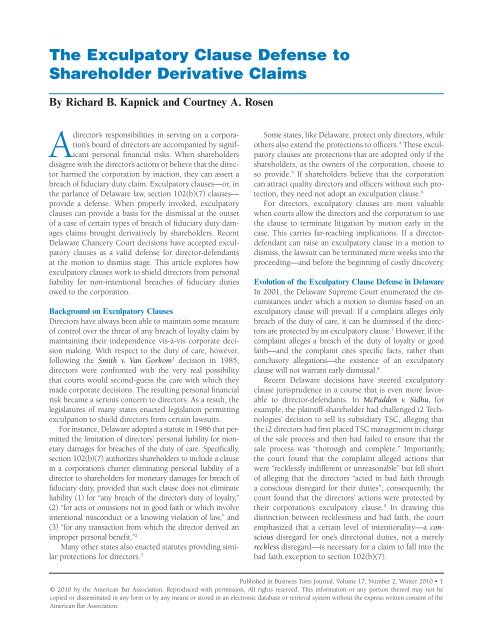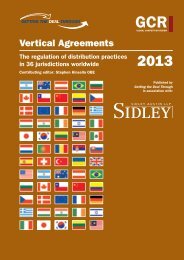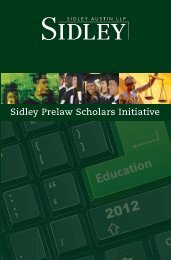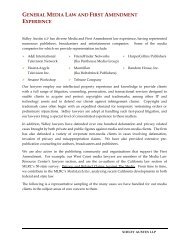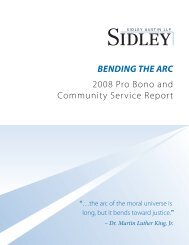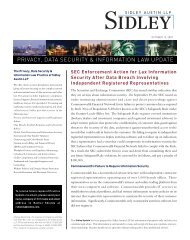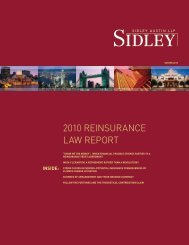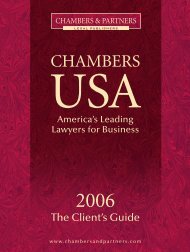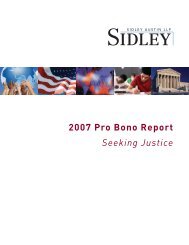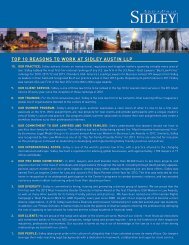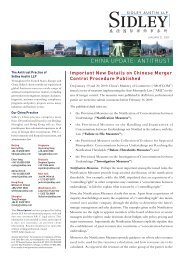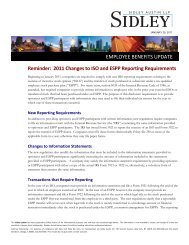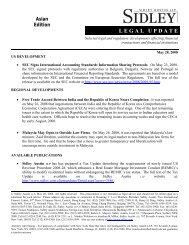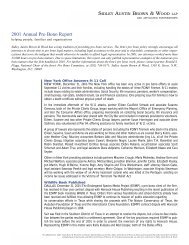The Exculpatory Clause Defense to Shareholder ... - Sidley Austin LLP
The Exculpatory Clause Defense to Shareholder ... - Sidley Austin LLP
The Exculpatory Clause Defense to Shareholder ... - Sidley Austin LLP
Create successful ePaper yourself
Turn your PDF publications into a flip-book with our unique Google optimized e-Paper software.
<strong>The</strong> <strong>Exculpa<strong>to</strong>ry</strong> <strong>Clause</strong> <strong>Defense</strong> <strong>to</strong><br />
<strong>Shareholder</strong> Derivative Claims<br />
By Richard B. Kapnick and Courtney A. Rosen<br />
A<br />
direc<strong>to</strong>r’s responsibilities in serving on a corporation’s<br />
board of direc<strong>to</strong>rs are accompanied by significant<br />
personal financial risks. When shareholders<br />
disagree with the direc<strong>to</strong>r’s actions or believe that the direc<strong>to</strong>r<br />
harmed the corporation by inaction, they can assert a<br />
breach of fiduciary duty claim. <strong>Exculpa<strong>to</strong>ry</strong> clauses—or, in<br />
the parlance of Delaware law, section 102(b)(7) clauses—<br />
provide a defense. When properly invoked, exculpa<strong>to</strong>ry<br />
clauses can provide a basis for the dismissal at the outset<br />
of a case of certain types of breach of fiduciary duty damages<br />
claims brought derivatively by shareholders. Recent<br />
Delaware Chancery Court decisions have accepted exculpa<strong>to</strong>ry<br />
clauses as a valid defense for direc<strong>to</strong>r-defendants<br />
at the motion <strong>to</strong> dismiss stage. This article explores how<br />
exculpa<strong>to</strong>ry clauses work <strong>to</strong> shield direc<strong>to</strong>rs from personal<br />
liability for non-intentional breaches of fiduciary duties<br />
owed <strong>to</strong> the corporation.<br />
Background on <strong>Exculpa<strong>to</strong>ry</strong> <strong>Clause</strong>s<br />
Direc<strong>to</strong>rs have always been able <strong>to</strong> maintain some measure<br />
of control over the threat of any breach of loyalty claim by<br />
maintaining their independence vis-à-vis corporate decision<br />
making. With respect <strong>to</strong> the duty of care, however,<br />
following the Smith v. Van Gorkom 1 decision in 1985,<br />
direc<strong>to</strong>rs were confronted with the very real possibility<br />
that courts would second-guess the care with which they<br />
made corporate decisions. <strong>The</strong> resulting personal financial<br />
risk became a serious concern <strong>to</strong> direc<strong>to</strong>rs. As a result, the<br />
legislatures of many states enacted legislation permitting<br />
exculpation <strong>to</strong> shield direc<strong>to</strong>rs from certain lawsuits.<br />
For instance, Delaware adopted a statute in 1986 that permitted<br />
the limitation of direc<strong>to</strong>rs’ personal liability for monetary<br />
damages for breaches of the duty of care. Specifically,<br />
section 102(b)(7) authorizes shareholders <strong>to</strong> include a clause<br />
in a corporation’s charter eliminating personal liability of a<br />
direc<strong>to</strong>r <strong>to</strong> shareholders for monetary damages for breach of<br />
fiduciary duty, provided that such clause does not eliminate<br />
liability (1) for “any breach of the direc<strong>to</strong>r’s duty of loyalty,”<br />
(2) “for acts or omissions not in good faith or which involve<br />
intentional misconduct or a knowing violation of law,” and<br />
(3) “for any transaction from which the direc<strong>to</strong>r derived an<br />
improper personal benefit.” 2<br />
Many other states also enacted statutes providing similar<br />
protections for direc<strong>to</strong>rs. 3<br />
Some states, like Delaware, protect only direc<strong>to</strong>rs, while<br />
others also extend the protections <strong>to</strong> officers. 4 <strong>The</strong>se exculpa<strong>to</strong>ry<br />
clauses are protections that are adopted only if the<br />
shareholders, as the owners of the corporation, choose <strong>to</strong><br />
so provide. 5 If shareholders believe that the corporation<br />
can attract quality direc<strong>to</strong>rs and officers without such protection,<br />
they need not adopt an exculpation clause. 6<br />
For direc<strong>to</strong>rs, exculpa<strong>to</strong>ry clauses are most valuable<br />
when courts allow the direc<strong>to</strong>rs and the corporation <strong>to</strong> use<br />
the clause <strong>to</strong> terminate litigation by motion early in the<br />
case. This carries far-reaching implications. If a direc<strong>to</strong>rdefendant<br />
can raise an exculpa<strong>to</strong>ry clause in a motion <strong>to</strong><br />
dismiss, the lawsuit can be terminated mere weeks in<strong>to</strong> the<br />
proceeding—and before the beginning of costly discovery.<br />
Evolution of the <strong>Exculpa<strong>to</strong>ry</strong> <strong>Clause</strong> <strong>Defense</strong> in Delaware<br />
In 2001, the Delaware Supreme Court enumerated the circumstances<br />
under which a motion <strong>to</strong> dismiss based on an<br />
exculpa<strong>to</strong>ry clause will prevail: If a complaint alleges only<br />
breach of the duty of care, it can be dismissed if the direc<strong>to</strong>rs<br />
are protected by an exculpa<strong>to</strong>ry clause. 7 However, if the<br />
complaint alleges a breach of the duty of loyalty or good<br />
faith—and the complaint cites specific facts, rather than<br />
conclusory allegations—the existence of an exculpa<strong>to</strong>ry<br />
clause will not warrant early dismissal. 8<br />
Recent Delaware decisions have steered exculpa<strong>to</strong>ry<br />
clause jurisprudence in a course that is even more favorable<br />
<strong>to</strong> direc<strong>to</strong>r-defendants. In McPadden v. Sidhu, for<br />
example, the plaintiff-shareholder had challenged i2 Technologies’<br />
decision <strong>to</strong> sell its subsidiary TSC, alleging that<br />
the i2 direc<strong>to</strong>rs had first placed TSC management in charge<br />
of the sale process and then had failed <strong>to</strong> ensure that the<br />
sale process was “thorough and complete.” Importantly,<br />
the court found that the complaint alleged actions that<br />
were “recklessly indifferent or unreasonable” but fell short<br />
of alleging that the direc<strong>to</strong>rs “acted in bad faith through<br />
a conscious disregard for their duties”; consequently, the<br />
court found that the direc<strong>to</strong>rs’ actions were protected by<br />
their corporation’s exculpa<strong>to</strong>ry clause. 9 In drawing this<br />
distinction between recklessness and bad faith, the court<br />
emphasized that a certain level of intentionality—a conscious<br />
disregard for one’s direc<strong>to</strong>rial duties, not a merely<br />
reckless disregard—is necessary for a claim <strong>to</strong> fall in<strong>to</strong> the<br />
bad faith exception <strong>to</strong> section 102(b)(7).<br />
Published in Business Torts Journal, Volume 17, Number 2, Winter 2010 • 1<br />
© 2010 by the American Bar Association. Reproduced with permission. All rights reserved. This information or any portion thereof may not be<br />
copied or disseminated in any form or by any means or s<strong>to</strong>red in an electronic database or retrieval system without the express written consent of the<br />
American Bar Association.
In re Lear Corporation <strong>Shareholder</strong>s Litigation 10 reinforced<br />
this distinction. In Lear, the shareholder-plaintiffs<br />
alleged that the direc<strong>to</strong>rs of Lear had acted in bad faith by<br />
agreeing <strong>to</strong> pay a $25 million “no-vote termination fee”<br />
<strong>to</strong> a potential acquirer in exchange for a $1.25 increase<br />
in the proposed merger price. Despite the plaintiffs’ characterization<br />
of their claim as one alleging breach of the<br />
direc<strong>to</strong>rs’ duty <strong>to</strong> act in good faith, the court found that<br />
the shareholder-plaintiffs had failed <strong>to</strong> show that the direc<strong>to</strong>rs<br />
were not protected by Lear’s exculpa<strong>to</strong>ry charter clause<br />
and, accordingly, dismissed the complaint. In so finding, it<br />
warned that courts should “be extremely chary about labeling<br />
what they perceive as deficiencies in the deliberations<br />
of an independent board majority . . . as not merely negligence<br />
or even gross negligence, but as involving bad faith.”<br />
<strong>The</strong> court emphasized that absent allegations of “an illicit<br />
direc<strong>to</strong>rial motive,” it can be “difficult” for a plaintiff <strong>to</strong> raise<br />
a viable bad faith claim. 11 In this way, the court reiterated<br />
that conscious wrongdoing is a critical element of direc<strong>to</strong>rial<br />
bad faith, just as the McPadden court had done. 12<br />
<strong>Exculpa<strong>to</strong>ry</strong> <strong>Clause</strong>s in Other Jurisdictions<br />
Dozens of other jurisdictions have heard exculpa<strong>to</strong>ry<br />
clause cases, and while many simply follow the Delaware<br />
judiciary’s lead, others have forged their own<br />
independent understandings. Pleading around section<br />
102(b)(7) should be considered a substantive element<br />
of any claim against a Delaware direc<strong>to</strong>r whose corporation<br />
has such a provision in its charter, and for that<br />
reason, courts in other jurisdictions applying Delaware<br />
law should consider themselves bound <strong>to</strong> enforce section<br />
102(b)(7) at the motion <strong>to</strong> dismiss stage, just as the<br />
Delaware courts do. To do otherwise only encourages<br />
plaintiff forum shopping.<br />
Federal Courts<br />
Several federal courts have weighed in on two key interpretive<br />
issues: first, whether a defendant can base a motion<br />
<strong>to</strong> dismiss on the protections afforded by an exculpa<strong>to</strong>ry<br />
clause; and, second, whether direc<strong>to</strong>rial acts that are<br />
merely reckless—but not conscious or intentional—can be<br />
exculpated by a section 102(b)(7) exculpa<strong>to</strong>ry clause.<br />
First, some federal courts applying Delaware law have<br />
denied motions <strong>to</strong> dismiss founded on section 102(b)(7)<br />
clauses, theorizing that this defense is not properly asserted<br />
in a motion <strong>to</strong> dismiss, but is analogous <strong>to</strong> an affirmative<br />
defense that may be raised only at a later stage in the proceedings.<br />
<strong>The</strong> District Court for the District of Arizona, for<br />
example, has held that a “statu<strong>to</strong>ry liability shield provided<br />
by a certificate of incorporation . . . is in the nature of an<br />
affirmative defense” and thus is inappropriate for consideration<br />
in the context of a motion <strong>to</strong> dismiss for failure <strong>to</strong><br />
state a claim. 13 <strong>The</strong> District of Delaware has broken with<br />
Delaware state courts on this issue, holding recently that<br />
“[b]ecause a Section 102(b)(7) provision is in the nature of<br />
an affirmative defense and following the statement of the<br />
Third Circuit that such defenses will generally not form<br />
the basis of a Rule 12(b)(6) dismissal, defendants’ motion<br />
<strong>to</strong> dismiss the duty of care claims is denied.” 14<br />
<strong>The</strong> reluctance of these jurisdictions <strong>to</strong> grant a motion<br />
<strong>to</strong> dismiss based on an exculpa<strong>to</strong>ry clause defense contrasts<br />
with the result in the Delaware state courts, where<br />
a direc<strong>to</strong>r is permitted <strong>to</strong> use an exculpa<strong>to</strong>ry clause <strong>to</strong><br />
dismiss a duty of care claim at the outset of a case. <strong>The</strong>se<br />
federal cases are based on snippets of quotations from<br />
older Delaware cases implying that section 102(b)(7) is<br />
in the nature of an affirmative defense and ignore more<br />
recent Delaware case law that demands the plaintiff plead<br />
around the requirements of the exculpa<strong>to</strong>ry clause as a<br />
substantive element of a claim against any direc<strong>to</strong>r of a<br />
corporation with a section 102(b)(7) charter clause. 15<br />
Second, in granting defendants’ motions <strong>to</strong> dismiss, two<br />
federal courts, applying Delaware law, recently addressed<br />
the type of direc<strong>to</strong>rial behavior that should be labeled<br />
“in bad faith.” Both of these cases involved allegations of<br />
direc<strong>to</strong>rial bad faith that were found <strong>to</strong> be inadequate. <strong>The</strong><br />
Northern District of Illinois, for example, recited the bad<br />
faith standard correctly as requiring “a conscious disregard<br />
[of] responsibilities” and held that the defendants’ alleged<br />
failure <strong>to</strong> act in response <strong>to</strong> a single communication from<br />
a regula<strong>to</strong>ry agency did not constitute bad faith where the<br />
plaintiff admitted that the defendants had set up a reporting<br />
system for addressing such communications. 16 Likewise,<br />
the District of Massachusetts, applying Delaware law,<br />
also correctly stated the bad faith standard as requiring “a<br />
conscious disregard of a known risk” and held that the<br />
defendants’ alleged failure <strong>to</strong> discover a fraud was not<br />
bad faith where the fraudulent ac<strong>to</strong>rs had concealed their<br />
actions and where the board had retained and relied upon<br />
professional advisors concerning the underlying matters. 17<br />
<strong>The</strong>se cases shed little light on whether either of these<br />
courts would rely in an appropriate case on an exculpa<strong>to</strong>ry<br />
clause as the exclusive ground for its decision.<br />
After the decisions of the Delaware Supreme Court in<br />
Lyondell and Disney, there should be no lack of clarity<br />
on the perennially thorny question of what constitutes<br />
direc<strong>to</strong>rial bad faith. <strong>The</strong> Delaware courts clearly have<br />
resolved <strong>to</strong> treat unintentional recklessness as fully exculpable<br />
and <strong>to</strong> require that such allegations be specifically<br />
made in the complaint in order <strong>to</strong> state a claim for relief<br />
against any direc<strong>to</strong>r whose company has an exculpa<strong>to</strong>ry<br />
clause. <strong>The</strong>re is every reason for the federal courts <strong>to</strong><br />
apply this substantive law in ruling on motions <strong>to</strong> dismiss<br />
shareholder claims.<br />
Published in Business Torts Journal, Volume 17, Number 2, Winter 2010 • 2<br />
© 2010 by the American Bar Association. Reproduced with permission. All rights reserved. This information or any portion thereof may not be<br />
copied or disseminated in any form or by any means or s<strong>to</strong>red in an electronic database or retrieval system without the express written consent of the<br />
American Bar Association.
State Courts<br />
Some plaintiffs’ counsel apparently believe that by filing lawsuits<br />
in a corporation’s principal place of business rather than<br />
in Delaware, they will benefit from ambiguities in those states’<br />
less-developed corporate law. A survey of the law in states<br />
other than Delaware reveals that there are few published<br />
opinions addressing section 102(b)(7) or similar exculpa<strong>to</strong>ry<br />
clauses. Broadly speaking, this dearth of published<br />
case law makes it unclear how courts in states other than<br />
Delaware will interpret an exculpa<strong>to</strong>ry clause. In the<br />
absence of a well-developed body of authority, the courts<br />
of many states will rely on applicable Delaware authorities<br />
in appropriate circumstances. 18 Whether this will occur in<br />
the context of exculpa<strong>to</strong>ry clauses remains <strong>to</strong> be seen.<br />
<strong>The</strong> limited case law that exists suggests that state<br />
courts have an inconsistent record in relying upon or<br />
enforcing exculpa<strong>to</strong>ry provisions. For example, in<br />
Shaper v. Bryan, the Illinois Appellate Court affirmed,<br />
under Delaware law, the dismissal of a due care claim,<br />
but failed <strong>to</strong> base its ruling on the exculpa<strong>to</strong>ry provision<br />
in the corporation’s charter. 19 In that case, the direc<strong>to</strong>rdefendants<br />
argued in their briefs that the section 102(b)<br />
(7) provision in their corporate charter shielded them<br />
from liability for the actions challenged by plaintiffs. 20<br />
Although ultimately ruling in favor of the defendants<br />
and dismissing the case, the Illinois court based its decision<br />
on the plaintiffs’ failure <strong>to</strong> allege sufficient facts <strong>to</strong><br />
rebut the business judgment rule; the court did not even<br />
mention the section 102(b)(7) provision in its opinion<br />
affirming the dismissal. 21<br />
Likewise, in Elloway v. Pate, the Texas Court of Appeals<br />
affirmed under Delaware law the lower court’s decision <strong>to</strong><br />
direct a verdict in favor of the direc<strong>to</strong>r-defendants on a<br />
due care claim, finding that the plaintiff “has not presented<br />
evidence that the Direc<strong>to</strong>rs’ conduct constitutes gross<br />
negligence.” 22 In reaching its ruling, the court did not rely<br />
upon the section 102(b)(7) clause in the company’s charter,<br />
which would have set the applicable standard even<br />
higher. 23 In fact, defendants themselves failed even <strong>to</strong> raise<br />
the exculpa<strong>to</strong>ry provision at the directed verdict hearing<br />
in the trial court—even though such an argument would<br />
have strongly supported a dismissal. 24 Both the courts and<br />
the lower court litigants displayed some reluctance <strong>to</strong> rely<br />
explicitly on a section 102(b)(7) defense.<br />
In New York, at least one court, applying Delaware law,<br />
emphasized that the “great deference given <strong>to</strong> the existence<br />
and legal effect of the exculpa<strong>to</strong>ry provision” seen in Delaware<br />
cases like Malpiede v. Townson is “highly influential”<br />
<strong>to</strong> the analysis dismissing the complaint. 25 Another New<br />
York court, applying Delaware law, went in a different<br />
direction, stating that section 102(b)(7) does not protect<br />
a direc<strong>to</strong>r against any complaint alleging that the direc<strong>to</strong>r<br />
engaged in “misconduct”—an overbroad statement obviously<br />
at odds with Delaware state courts’ interpretation<br />
of section 102(b)(7). 26 Nevertheless, the court dismissed<br />
the complaint, finding the allegations of misconduct <strong>to</strong> be<br />
“wholly conclusory” and insufficient <strong>to</strong> rebut the presumption<br />
of the business judgment rule.<br />
Further, one very recent case indicates that the New York<br />
courts might be willing <strong>to</strong> base a decision, applying Delaware<br />
law, directly on section 102(b)(7). In that case, a court<br />
confronted with an exculpa<strong>to</strong>ry clause dismissed the complaint<br />
in favor of defendants but did not rely exclusively on<br />
its protections, finding that the direc<strong>to</strong>rs’ actions in that case<br />
“would survive scrutiny” even heightened scrutiny, although<br />
such heightened scrutiny was “simply not warranted” in that<br />
case. 27 <strong>The</strong> court correctly articulated the legal standards<br />
under section 102(b)(7), but it never had the opportunity <strong>to</strong><br />
determine whether it would rely solely on the exculpa<strong>to</strong>ry<br />
provision as a basis for dismissal of the complaint. 28<br />
As for the California courts, it is worth noting that they<br />
have shown themselves inclined <strong>to</strong> limit the protections<br />
afforded by exculpa<strong>to</strong>ry clauses in general. In at least one<br />
case, the California Court of Appeals has interpreted a<br />
California state law clause analogous <strong>to</strong> section 102(b)<br />
(7) in a highly limited fashion, holding that “waiver of<br />
corporate direc<strong>to</strong>rs’ and majority shareholders’ fiduciary<br />
duties <strong>to</strong> minority shareholders in private close corporations<br />
is against public policy, and a contract provision . .<br />
. purporting <strong>to</strong> effect such a waiver is void.” 29 Strangely,<br />
the court relied on the California Corporations Code<br />
clause that, like section 102(b)(7), expressly authorizes<br />
such waivers. 30 <strong>The</strong> court found that the clause’s various<br />
exceptions forbidding the exculpation of acts taken<br />
in bad faith or intentional misconduct—which echo, in<br />
substance, the exceptions <strong>to</strong> section 102(b)(7)—indicate,<br />
in turn, that the state’s overarching policy is <strong>to</strong> strongly<br />
disfavor attempts <strong>to</strong> eliminate liability for any breach of<br />
fiduciary duty. This reasoning—which smacks strongly<br />
of a general suspicion of exculpa<strong>to</strong>ry clauses—indicates<br />
that the California state courts, given the opportunity,<br />
may limit the applicability of exculpa<strong>to</strong>ry clauses.<br />
Some state courts’ failure <strong>to</strong> base their rulings squarely<br />
on exculpa<strong>to</strong>ry clauses means that it is unclear how those<br />
courts will interpret section 102(b)(7) or similar provisions<br />
in the future. On the one hand, this failure may only<br />
indicate that state courts lack familiarity with the concept<br />
of an exculpa<strong>to</strong>ry clause, or it may indicate a reluctance<br />
<strong>to</strong> permit such defenses <strong>to</strong> be asserted at the dismissal<br />
stage. Either way, the courts of these states may be far less<br />
deferential <strong>to</strong> the shareholders’ decision <strong>to</strong> adopt exculpa<strong>to</strong>ry<br />
provisions. On the other hand, it is possible that<br />
some direc<strong>to</strong>rs’ counsel may have been reluctant <strong>to</strong> base<br />
arguments (and courts <strong>to</strong> base rulings) on the “bad faith”<br />
Published in Business Torts Journal, Volume 17, Number 2, Winter 2010 • 3<br />
© 2010 by the American Bar Association. Reproduced with permission. All rights reserved. This information or any portion thereof may not be<br />
copied or disseminated in any form or by any means or s<strong>to</strong>red in an electronic database or retrieval system without the express written consent of the<br />
American Bar Association.
exception <strong>to</strong> section 102(b)(7). Because recent Delaware<br />
cases have clarified that exception, practitioners and<br />
courts should come away with one lesson: Neither should<br />
be reluctant <strong>to</strong> rely on exculpa<strong>to</strong>ry clauses as the basis for<br />
an early dismissal.<br />
Using <strong>Exculpa<strong>to</strong>ry</strong> <strong>Clause</strong>s <strong>to</strong> <strong>The</strong>ir Fullest Effect<br />
<strong>Exculpa<strong>to</strong>ry</strong> clauses, such as the type authorized by section<br />
102(b)(7), can offer protection <strong>to</strong> direc<strong>to</strong>rs who find themselves<br />
defending against certain breach of fiduciary duty<br />
claims. <strong>The</strong> scope and usefulness of exculpa<strong>to</strong>ry clauses<br />
are greatly affected by the willingness of the forum courts<br />
<strong>to</strong> apply them. To date, a number of jurisdictions have<br />
failed <strong>to</strong> recognize the importance of exculpa<strong>to</strong>ry clauses<br />
in ruling on motions <strong>to</strong> dismiss. Likewise, counsel representing<br />
direc<strong>to</strong>rs in jurisdictions outside Delaware have<br />
not always explicitly raised the exculpa<strong>to</strong>ry clause defense<br />
at the motion <strong>to</strong> dismiss stage.<br />
Recent Delaware case law strongly demonstrates that<br />
it is appropriate <strong>to</strong> allow such defenses <strong>to</strong> be asserted at<br />
the motion <strong>to</strong> dismiss stage. <strong>The</strong> existence of the exculpa<strong>to</strong>ry<br />
clause requires that the shareholder-plaintiff satisfy<br />
an extremely high pleading standard <strong>to</strong> allow cases<br />
<strong>to</strong> go forward. Specifically, a shareholder-plaintiff must<br />
show that a direc<strong>to</strong>r must have committed “intentional<br />
dereliction of duty” or “a conscious disregard for one’s<br />
responsibilities.” 31 In light of this current trend in Delaware<br />
case law, counsel representing corporate direc<strong>to</strong>rs<br />
should consider raising appropriate exculpa<strong>to</strong>ry clause<br />
defenses at the earliest possible opportunity. n<br />
Richard B. Kapnick and Courtney A. Rosen are partners<br />
at <strong>Sidley</strong> <strong>Austin</strong> <strong>LLP</strong> in Chicago, Illinois. This article<br />
reflects the views of the authors only and not necessarily<br />
those of <strong>Sidley</strong> <strong>Austin</strong> <strong>LLP</strong>.<br />
Endnotes<br />
1. 488 A.2d 858, 893 (Del. 1985) (finding that direc<strong>to</strong>rs may<br />
be personally liable if their decision <strong>to</strong> approve merger was <strong>to</strong>o<br />
hasty or unsupported).<br />
2. Del. Co D e An n. tit. 8, § 102(b)(7) (2009).<br />
3. See, e.g., MD. Co D e An n., Cts. & Ju D. Pr o C. § 5-418(a)(1)-<br />
(2) (2009); n.Y. Bu s. Co r P. lA w § 402(b)(1) (McKinney 2009);<br />
805 Ill. Co M P. st A t. 5/2.10(b)(3) (2009). Maryland’s law is particularly<br />
relevant because Maryland is “by far the most popular<br />
state in which <strong>to</strong> organize a REIT [real estate investment trust].”<br />
Crossing the Line: Neighboring States Delaware and Maryland<br />
Are Miles Apart When It Comes <strong>to</strong> Laws Affecting REITs, re A l<br />
estAte Po r t f o l I o, Jan./Feb. 2002, www.realestateportfolio.com/<br />
portfoliomag/02janfeb/policy.shtml. Other states, such as Nevada,<br />
allow shareholders <strong>to</strong> adopt exculpa<strong>to</strong>ry charter provisions<br />
that appear <strong>to</strong> be even more favorable <strong>to</strong> direc<strong>to</strong>r-defendants,<br />
providing exculpation for a direc<strong>to</strong>r or an officer “unless it is<br />
proven that . . . [h]is breach of those duties involved intentional<br />
misconduct, fraud or a knowing violation of law.” nev. rev. st A t.<br />
§ 78.138(7) (2009).<br />
4. See, e.g., lA. rev. st A t. An n. § 12:24(C)(4) (2008); MD.<br />
Co D e An n., Cts. & Ju D. Pr o C. § 5-418(a) (2009); nev. rev. st A t.<br />
§ 78.037(2) (2009); n.J. st A t. An n. § 14A:2-7(3) (2009); vA.<br />
Co D e An n. § 13.1-692.1(A)(1) (2009).<br />
5. See Emerald Partners v. Berlin, 787 A.2d 85, 90 (Del.<br />
2001).<br />
6. Delaware courts have recognized that the exculpa<strong>to</strong>ry clause<br />
exists <strong>to</strong> “encourage direc<strong>to</strong>rs <strong>to</strong> undertake risky, but potentially<br />
value-maximizing, business strategies, so long as they do so in<br />
good faith.” See Prod. Res. Group, LLC v. NCT Group, Inc., 863<br />
A.2d 772, 777 (Del. Ch. 2004).<br />
7. Malpiede v. Townson, 780 A.2d 1075, 1094 (Del. 2001).<br />
Raising the exculpa<strong>to</strong>ry clause in a motion <strong>to</strong> dismiss may convert<br />
the motion in<strong>to</strong> one for summary judgment, but “it does not<br />
follow that the ‘floodgates of discovery’ have <strong>to</strong> be opened.” Id.<br />
at 1091. Discovery, if any, is limited <strong>to</strong> issues such as the authenticity<br />
of the exculpa<strong>to</strong>ry provision and whether it was properly<br />
adopted by the shareholders. Id. at 1092. Alternatively, the court<br />
may take judicial notice of the exculpa<strong>to</strong>ry clause. See Khanna v.<br />
McMinn, No. 20545-NC, 2006 Del. Ch. LEXIS 86, at *130 (Del.<br />
Ch. May 9, 2006) (the court may “take judicial ‘notice of matters<br />
that are not subject <strong>to</strong> reasonable dispute’”) (internal quotation<br />
omitted).<br />
8. See Emerald Partners, 787 A.2d at 92; see also Alidina v.<br />
Internet.com Corp., No. 17235–NC, 2002 Del. Ch. LEXIS 156,<br />
at *28 (Del. Ch. Nov. 6, 2002) (holding that “when a duty of care<br />
breach is not the exclusive claim [i.e., the duty of loyalty is implicated],<br />
. . . the § 102(b)(7) provision cannot operate <strong>to</strong> negate<br />
plaintiffs’ duty of care claim on a motion <strong>to</strong> dismiss”).<br />
9. McPadden v. Sidhu, 964 A.2d 1262, 1275 (Del. Ch.<br />
2008).<br />
10. No. 2728-VCS, 2008 Del. Ch. LEXIS 121 (Del. Ch. 2,<br />
2008).<br />
11. In re Lear Corp. S’holder Litig., 2008 Del. Ch. LEXIS at<br />
*20, 23, 25, 36, 41–43, n.62.<br />
12. <strong>Exculpa<strong>to</strong>ry</strong> clauses like Delaware’s section 102(b)(7)<br />
effectively may also be employed in motions <strong>to</strong> dismiss derivative<br />
lawsuits for failure <strong>to</strong> make demand under Rule 23.1. In<br />
Wood v. Baum, 953 A.2d 136 (Del. 2008), the Delaware Supreme<br />
Court held that when courts adjudicate the sufficiency of allegations<br />
of demand futility, they should take exculpa<strong>to</strong>ry clauses<br />
in<strong>to</strong> account and that a derivative complaint should be dismissed<br />
where, as in that case, there are no particularized allegations that<br />
the direc<strong>to</strong>rs “had ‘actual or constructive knowledge’ that their<br />
conduct was legally improper.” Id. at 141. Wood effectively combines<br />
Rule 23.1 and section 102(b)(7) at the earliest procedural<br />
stage <strong>to</strong> filter out derivative claims that do not allege conscious<br />
knowledge of wrongdoing. See also In re ITT Corp. Deriv. Litig.,<br />
Published in Business Torts Journal, Volume 17, Number 2, Winter 2010 • 4<br />
© 2010 by the American Bar Association. Reproduced with permission. All rights reserved. This information or any portion thereof may not be<br />
copied or disseminated in any form or by any means or s<strong>to</strong>red in an electronic database or retrieval system without the express written consent of the<br />
American Bar Association.
588 F. Supp. 2d 502 (S.D.N.Y. 2008) (granting motion <strong>to</strong> dismiss<br />
on futility grounds); In re Extreme Networks, Inc. S’holder Deriv.<br />
Litig., 573 F. Supp. 2d 1228 (N.D. Cal. 2008) (same); In re Citigroup<br />
Inc. S’holder Deriv. Litig., 964 A.2d 106 (Del. Ch. 2009)<br />
(same).<br />
13. In re TASER Int’l S’holder Deriv. Litig., No. CV-05-123-<br />
PHX-SRB, 2006 U.S. Dist. LEXIS 11554, at *59 (D. Ariz. Mar. 17,<br />
2006) (internal quotation omitted).<br />
14. Ad Hoc Comm. of Equity Holders of Tec<strong>to</strong>nic Network,<br />
Inc. v. Wolford, 554 F. Supp. 2d 538, 561 (D. Del. 2008). See<br />
also Collins & Aikman Corp. v. S<strong>to</strong>ckman, No. 07-265-SLR-LPS,<br />
2009 WL 1530120, at *20 (D. Del. May 20, 2009).<br />
15. See Emerald Partners. v. Berlin, 787 A.2d at 92 (“[I]n<br />
actions against the direc<strong>to</strong>rs of Delaware corporations with a<br />
Section 102(b)(7) charter provision, a shareholder’s complaint<br />
must allege well-pled facts that, if true, implicate breaches of<br />
loyalty or good faith.”); see also In re Medtronic, 622 F. Supp.<br />
802, 809 (D. Minn. 2009) (dismissing derivative claim under<br />
Minnesota law for failure <strong>to</strong> make a demand and noting that<br />
exculpa<strong>to</strong>ry clause requires “the more difficult burden of pleading<br />
a non-exculpated claim <strong>to</strong> avoid dismissal”).<br />
16. Bronstein v. <strong>Austin</strong>, No. 07 C 3984, 2008 U.S. Dist. LEXIS<br />
42881, *14–16 (N.D. Ill. May 30, 2008).<br />
17. Nisselson v. Lernout, 568 F. Supp. 2d 137, 149 (D. Mass.<br />
July 25, 2008).<br />
18. See e.g., In re F5 Networks, Inc., Deriv. Litig., No. C06-<br />
794RSL, 2007 U.S. Dist. LEXIS 57464, at *7 (W.D. Wash. Aug. 6,<br />
2007); Shoen v. SAC Holding Corp., 137 P.3d 1171, 1187 (Nev.<br />
2006).<br />
19. Shaper v. Bryan, 371 Ill. App. 3d 1079, 1082 (Ill. App. Ct.<br />
2007).<br />
20. Brief of Defendants-Appellees at 41, Shaper, 371 Ill. App.<br />
3d 1079 (No. 1-05-3849).<br />
21. Shaper, 371 Ill. App. 3d at 1082. Illinois courts are internally<br />
inconsistent on this. See Sherman v. Ryan, No. 1-07-2944,<br />
2009 Ill. App. LEXIS 300, at *39–40, *15 (Ill. App. Ct. May 20,<br />
2009) (relying in part on the company’s section 102(b)(7) clause<br />
for the court’s dismissal for failure <strong>to</strong> state a claim).<br />
22. Elloway v. Pate, 238 S.W.3d 882, 896 (Tex. Ct. App.<br />
2007).<br />
23. See also Ind. State Dist. Council of Laborers v. Brukardt,<br />
No. M2007-02271-COA-R3-CV, 2009 Tenn. App. LEXIS 269, at<br />
*34 (Tenn. Ct. App. Feb. 19, 2009) (holding that the complaint<br />
sufficiently alleged bad faith <strong>to</strong> avoid exculpa<strong>to</strong>ry clause defense<br />
in motion <strong>to</strong> dismiss).<br />
24. See id.<br />
25. See Kensing<strong>to</strong>n Int’l Ltd. v. Hiner, No. 602748/03, 2006<br />
N.Y. Misc. LEXIS 2321, at *14 (N.Y. Sup. Ct. Aug. 22, 2006).<br />
26. See Potter v. Arring<strong>to</strong>n, 810 N.Y.S.2d 312, 317 (N.Y. Sup.<br />
Ct. 2006). This statement appears as part of a larger, somewhat<br />
unclear, analysis in which the court states that “[a] direc<strong>to</strong>r may<br />
not exempt himself or herself from acts of misconduct,” but then<br />
goes on <strong>to</strong> dismiss certain causes of action that “only alleged misconduct<br />
and similar improper actions.”<br />
27. See In re Bear Stearns Litig., No. 600780/08, 2008 N.Y.<br />
Misc. LEXIS 7075, at *2, 17 (N.Y. Sup. Ct. Dec. 4. 2008).<br />
28. See id.<br />
29. Neubauer v. Goldfarb, 108 Cal. App. 4th 47, 57 (Cal. Ct.<br />
App. 2003).<br />
30. Id. (interpreting CA l. Co r P. Co D e § 204(a)(10)).<br />
31. In re Walt Disney Co. Deriv. Litig., 906 A.2d at 62, 67;<br />
Lyondell Chem. Co., 970 A.2d at 240.<br />
Published in Business Torts Journal, Volume 17, Number 2, Winter 2010 • 5<br />
© 2010 by the American Bar Association. Reproduced with permission. All rights reserved. This information or any portion thereof may not be<br />
copied or disseminated in any form or by any means or s<strong>to</strong>red in an electronic database or retrieval system without the express written consent of the<br />
American Bar Association.


